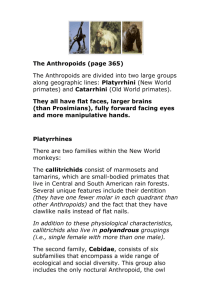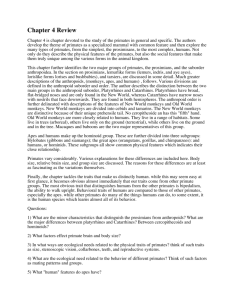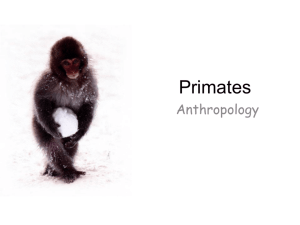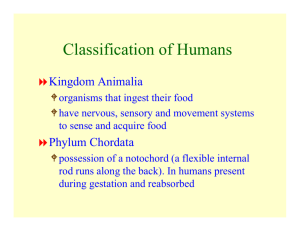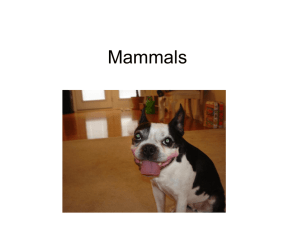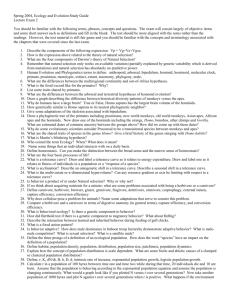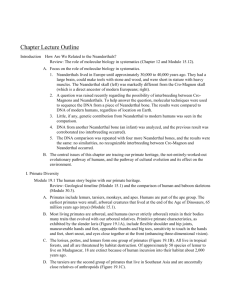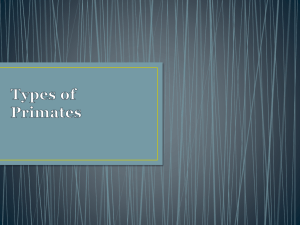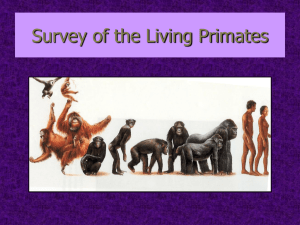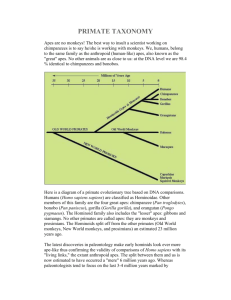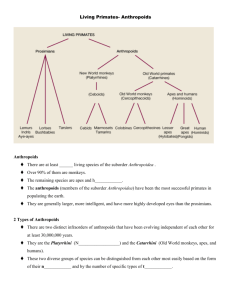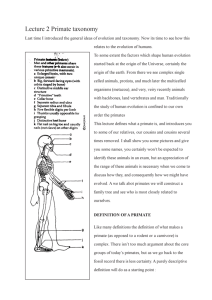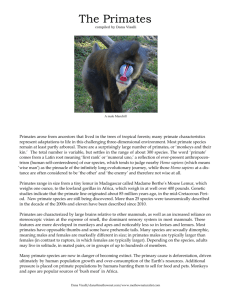An introduction to our relatives: Catarrhines
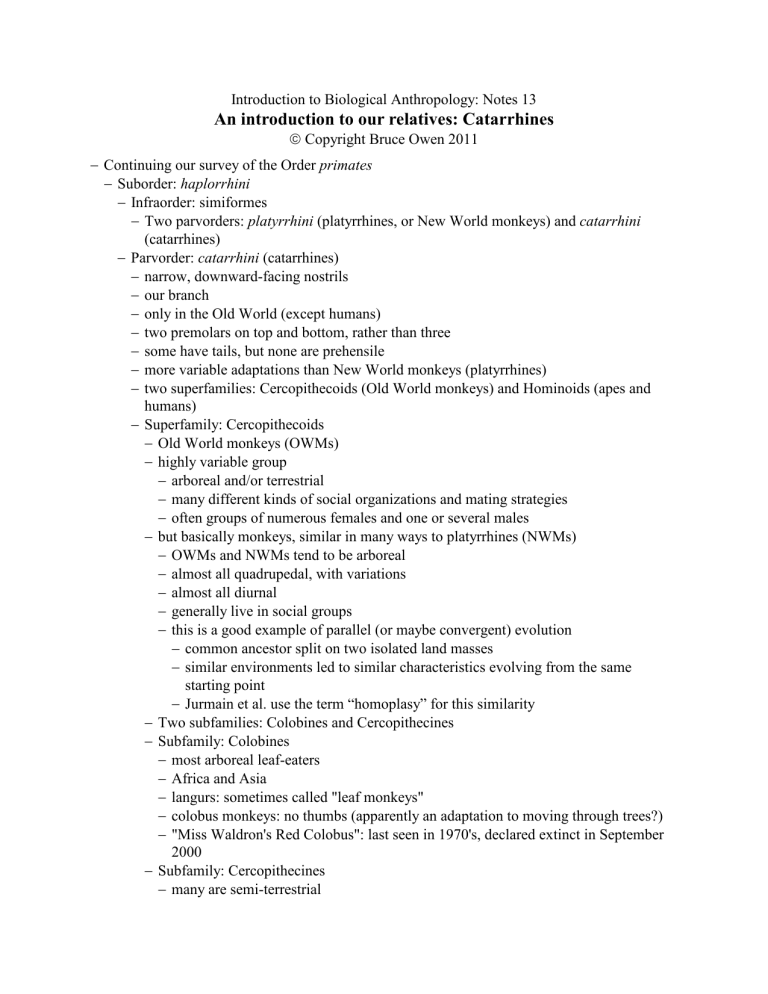
Introduction to Biological Anthropology: Notes 13
An introduction to our relatives: Catarrhines
Copyright Bruce Owen 2011
−
Continuing our survey of the Order primates
−
Suborder: haplorrhini
−
Infraorder: simiformes
−
Two parvorders: platyrrhini (platyrrhines, or New World monkeys) and catarrhini
(catarrhines)
−
Parvorder: catarrhini (catarrhines)
− narrow, downward-facing nostrils
− our branch
− only in the Old World (except humans)
− two premolars on top and bottom, rather than three
− some have tails, but none are prehensile
− more variable adaptations than New World monkeys (platyrrhines)
− two superfamilies: Cercopithecoids (Old World monkeys) and Hominoids (apes and humans)
−
Superfamily: Cercopithecoids
−
Old World monkeys (OWMs)
− highly variable group
− arboreal and/or terrestrial
− many different kinds of social organizations and mating strategies
− often groups of numerous females and one or several males
− but basically monkeys, similar in many ways to platyrrhines (NWMs)
−
OWMs and NWMs tend to be arboreal
− almost all quadrupedal, with variations
− almost all diurnal
− generally live in social groups
− this is a good example of parallel (or maybe convergent) evolution
− common ancestor split on two isolated land masses
− similar environments led to similar characteristics evolving from the same starting point
−
Jurmain et al. use the term “homoplasy” for this similarity
−
Two subfamilies: Colobines and Cercopithecines
−
Subfamily: Colobines
− most arboreal leaf-eaters
−
Africa and Asia
− langurs: sometimes called "leaf monkeys"
− colobus monkeys: no thumbs (apparently an adaptation to moving through trees?)
−
"Miss Waldron's Red Colobus": last seen in 1970's, declared extinct in September
2000
−
Subfamily: Cercopithecines
− many are semi-terrestrial
Intro to Biological Anthro F 2011 / Owen: Intro To Our Relatives: Catarrhines p. 2
− species are quite varied
−
Africa, plus macaques also live in Asia
− typically live in large, multi-male, multi-female groups
− baboons
− macaques
− vervet monkeys
−
Hominoids
− our branch: apes and humans
− which is redundant, since humans are really just another kind of ape
− generally the largest primates
− no tails
− relatively larger brains and more complex behavior
−
Y-5 molars
− basically forest dwellers, more or less arboreal, flexible tree climbing adaptation
− arms longer than legs
− lower back shorter, less flexible
− wide chest with shoulder blades (scapulae) on the back, rather than on the side as in quadrupeds
− so the forelimbs can stick out sideways, rather than just moving forward and back
− greater mobility of shoulders, elbows, wrists
− these are presumably adaptations for complex climbing in trees, rather than just walking on top of branches
− traditional classification has three families: hylobatids (lesser apes), pongids (great apes), and hominids (us)
− we will use the more correct one in which hominids are included among the great apes
−
Family: hylobatids (lesser apes)
−
"lesser apes", generally smaller than the pongids
− gibbons and siamangs
− live in tropical forests of Asia
− nearly full-time brachiators (overhand swingers through the trees) with very long arms
− mostly monogamous mating
− long-term pair bonded mates
− live with a few offspring and no other adults
− little sexual dimorphism
− males and females physically similar
− little difference in size or features
− hard to tell apart at the zoo!
− males more involved in infant care than most other primates, especially the siamangs
− highly territorial
−
Family: hominids (great apes)
Intro to Biological Anthro F 2011 / Owen: Intro To Our Relatives: Catarrhines p. 3
−
Orangutans, gorillas, chimpanzees, bonobos, and humans
− generally the largest primates
− generally the largest brains relative to body size
− this term is a bit confusing, since many older sources use “hominid” to refer to our species and our ancestors
− this was technically incorrect for arcane reasons we won’t go into here
− but the result is that the incorrect use is still probably more common than the correct use shown here
− divided into two subfamilies
− subfamily: pongines
− includes only orangutans
− only on southeast Asian islands of Sumatra and Borneo
− extreme sexual dimorphism in size, face, etc.
− quadrumanual and arboreal when small, more terrestrial when grown to large size
(especially males)
− very solitary
− fruit, leaf, and bark eater
− now commonly divided into two species, one from the large island of Borneo, the other from the large island of Sumatra
− subfamily: hominines
− the hominines are gorillas, chimps, bonobos, and humans
− note: hominine ends with an “e”
− the term for just our species and our ancestors and extinct close relatives is hominin with no “e”
− what used to be (incorrectly) called hominids
− we will use “hominin” a lot when we look at the fossil record
− but it rarely appears on taxonomic charts like the one we are using here, since they usually don’t show extinct species
− gorillas
− central African forests
− small groups of one or two adult males, a few females, some young
− eat leaves, stalks, bamboo
− mostly terrestrial (although this may vary depending on their environment)
− now commonly divided into two species, mountain gorillas and lowland gorillas
− chimpanzees
− and their close relatives, bonobos
− called "pygmy chimps", even though they are not consistently much smaller
− mostly eat plants, especially fruit, but sometimes insects and other animals
− common chimps: large multi-male, multi-female groups centered on a stable group of related males who stay in their natal group
− bonobos: female-centered groups
− regularly use tools and modify objects to serve as tools
− strip twigs to "fish" for termites or ants
Intro to Biological Anthro F 2011 / Owen: Intro To Our Relatives: Catarrhines p. 4
− wad up leaves to sponge water out of cavities in tree trunks
− crack nuts using a stone in one hand and a larger stone or root as an anvil
−
Hominins (no “e”): humans and our immediate ancestors and extinct relatives
− hominins (often incorrectly called hominids) were traditionally placed in their own family
− as if our lineage had long been separate from the other apes (then called pongids)
− this was basically vanity
− the evidence suggests instead that we are just another kind of great ape
− probably more closely related to chimps than gorillas are
− much more detail later, but for now:
− habitual, specialized bipedal locomotion
− reduced canines
− huge brains for body size
−
Many non-human primates are in danger of extinction
− capture for sale for pets or research (now partially controlled)
− hunting for exotic meat or trophies for sale
− hunted for "bush meat": in some areas, wild animals are not owned by anyone nor effectively protected, so they are a source of cheap meat or minor income for desperate people who can't afford beef, pork, or other preferred species
− humans are driving our only close relatives to extinction for the equivalent of cheap horsemeat
− but ultimately, the biggest reason is the reduction of habitat by logging, farming, ranching
− there are fewer and fewer "wild" places where they can live
−
We will come back to many of these primates as examples or case studies
